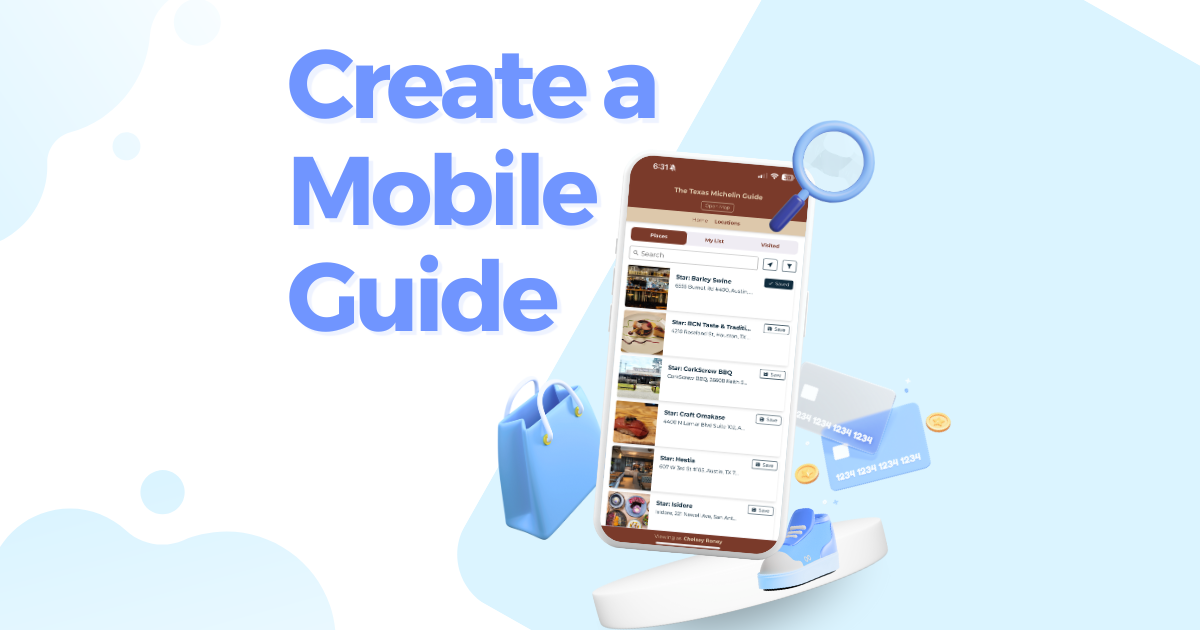.png)
The Civic Design Center has been a cornerstone of Nashville’s growth and development for over two decades. Their work has touched every corner of the city, from crafting large-scale design visions to engaging communities in meaningful dialogue about the future of their neighborhoods. Now, they’re showcasing their impactful projects in a dynamic and interactive way through their Project Portfolio Map on Proxi. This map is more than just a visual collection of their work; it’s a testament to the power of design in shaping vibrant, equitable communities.
What is a Project Portfolio Map?
A Project Portfolio Map is an interactive tool that allows organizations to visually display their projects on a Proxi map, bringing their work to life in a way that traditional portfolios or PDFs simply can’t match. By pinning projects to specific locations, these maps add a critical layer of context - place. This geographical context helps viewers quickly understand where each project is located, providing a deeper connection between the work and its physical environment. Each point on the map is enriched with detailed descriptions, images, and links to additional resources, making it easy for viewers to dive into the specifics of each initiative.
What sets a Project Portfolio Map apart is its dynamic and engaging nature. Unlike static documents, digital maps are interactive, allowing users to explore projects in a way that feels intuitive and immersive. Viewers can click on map points to reveal pop-ups with rich content, scroll through image galleries, watch embedded videos, and follow links to learn more. The map’s design can be customized to reflect the organization’s branding, making it a visually cohesive experience that draws viewers in. Additionally, these maps are easily updated, ensuring that the information remains current and relevant, which keeps the audience engaged over time. For the Civic Design Center, this means their map not only tells the story of their work but does so in a way that actively involves the community, inviting them to explore and engage with the projects that shape their city.
Why Civic Design Center’s Map is a Game-Changer
The Civic Design Center’s map is a prime example of how organizations can use digital tools to enhance their storytelling and outreach. Here’s why their map stands out:
Customized Branding: The map is uniquely theirs, with a branded header, logo, and personalized background styles that reflect their identity.
Rich Content: Each map point is filled with detailed descriptions, images, and links, providing a comprehensive look at each project.
Easy Sharing: Embedded directly on their site, this map is easy to share via newsletters, social media, and more, ensuring their work reaches a wide audience.
Who Can Benefit from a Project Portfolio Map?
Project Portfolio Maps aren’t just for design centers - they’re valuable for any organization or individual looking to showcase their work in a visually compelling way. Here are a few examples:
Nonprofits
Nonprofits can use Project Portfolio Maps to visually display their community projects and initiatives, making it easier for donors, volunteers, and stakeholders to see the direct impact of their efforts. By highlighting the locations of various programs, such as food banks, shelters, or educational centers, these maps help illustrate how the organization’s work is spread across different areas, creating a powerful visual narrative of their mission. Additionally, by including detailed descriptions, images, and links, nonprofits can provide more context and encourage further engagement with their cause.
Architects
For architects, a Project Portfolio Map is an ideal way to showcase completed buildings and developments. By mapping out their projects, architects can create a visually engaging portfolio that not only highlights the design but also places it within its geographical context, helping clients understand the impact of the project on its surroundings. This tool can be particularly useful for highlighting the diversity of work, from residential homes to large-scale commercial developments, and demonstrating how each project contributes to the urban landscape.
Municipalities
Municipalities can benefit from Project Portfolio Maps by presenting ongoing and completed public works projects in a transparent and accessible manner. These maps can serve as a public communication tool, allowing residents to see where taxpayer dollars are being spent and how different projects are progressing. Whether it’s a new park, road construction, or infrastructure improvements, municipalities can use the map to keep the community informed and engaged. The visual nature of the map also helps to clarify complex projects, making it easier for residents to understand the scope and impact of the work being done.
Consultants
Consultants can use Project Portfolio Maps to share case studies and client success stories in a way that is both visually compelling and easy to navigate. By mapping out where their consulting projects have taken place, consultants can demonstrate the breadth and reach of their expertise. Each point on the map can detail the challenges faced, solutions provided, and outcomes achieved, providing potential clients with a clear understanding of the consultant’s capabilities. This not only enhances the consultant’s portfolio but also helps build trust and credibility with prospective clients.
Event Planners
Event planners can use Project Portfolio Maps to highlight event venues, logistics, and past successes. By mapping out locations for events such as conferences, weddings, or festivals, planners can provide potential clients with a clear view of the possibilities. Each venue can be accompanied by descriptions, photos, and even testimonials, making it easier for clients to envision their event in that space. Additionally, planners can use the map to showcase logistical aspects, such as parking, transportation routes, and nearby accommodations, ensuring clients have all the information they need to make informed decisions.
Why Choose a Project Portfolio Map Over Standard PDFs?
Moving beyond static PDFs to an interactive Proxi project portfolio offers several advantages:
Interactivity
Unlike static PDFs, a Project Portfolio Map allows viewers to engage directly with the content. Users can click on different map points to explore specific projects, read detailed descriptions, and view related images or videos. This level of interaction makes the experience more engaging and memorable, encouraging deeper exploration of your work.
Updatability
One of the key benefits of a digital map is its ease of updating. As projects progress or new initiatives are launched, you can quickly and effortlessly update your map to reflect the latest information. This ensures that your portfolio remains current and relevant, without the need for reprinting or redistributing materials.
Accessibility
Project Portfolio Maps are highly accessible, thanks to shareable links that can be easily distributed across various platforms. Whether you’re sharing the map via email, embedding it on a website, or posting it on social media, it’s simple for your audience to access and explore the content. This wide reach ensures that your work is seen by as many people as possible.
Comprehensive Details
A Project Portfolio Map allows you to go beyond basic text descriptions by embedding rich media, such as videos, images, and even interactive elements. This multimedia approach provides a more comprehensive and immersive experience, allowing viewers to fully understand the scope and impact of each project. It’s a powerful way to bring your work to life.
Increased Reach
Because Project Portfolio Maps can be embedded directly into websites, blogs, and newsletters, they offer increased visibility compared to static documents. This flexibility allows you to showcase your work across multiple channels, reaching a broader audience and maximizing the impact of your portfolio.
Analytics
Another significant advantage of digital maps is the ability to track viewer engagement and map performance through analytics. You can monitor how often your map is viewed, which projects attract the most interest, and how users interact with the content. This data provides valuable insights that can inform future project presentations and marketing strategies, helping you optimize your outreach efforts.
Visual Appeal
Custom branding and visuals make Project Portfolio Maps much more visually appealing than traditional PDFs. You can tailor the map’s design to match your organization’s identity, using colors, fonts, and logos that reinforce your brand. This cohesive and polished presentation captures attention and keeps viewers engaged longer.
How to Build Your Digital Project Portfolio Map with Proxi
Creating your own Project Portfolio Map on Proxi is straightforward and rewarding. Here’s a quick outline guide to get you started:
1. Create a Base Map
Begin by setting up a map outline to serve as the foundation for your portfolio. You can easily kickstart your map using Proxi’s customizable templates, designed to get you up and running quickly.
2. Add Project Points
Pin each of your projects onto the map, providing detailed descriptions, links to additional resources, and images that bring your work to life. Whether you prefer adding points individually or want to save time by uploading a list using Proxi’s spreadsheet function, you’ll find it easy to populate your map with all the relevant information.
3. Enhance with Media
Take your map to the next level by embedding rich media, such as YouTube videos, infographics, or any other content that adds depth to your project descriptions. This multimedia approach helps create a more immersive and engaging experience for viewers.
4. Customize Your Map
Make your map truly reflect your brand by customizing it with your preferred colors, fonts, and background styles. This not only makes the map visually appealing but also ensures it aligns with your organization’s identity.
5. Add Your Logo
Incorporate your organization’s logo into the map to reinforce your branding and make the map unmistakably yours. A well-placed logo adds a professional touch and enhances the overall presentation.
6. Develop Custom CTAs
Guide your viewers toward specific actions by creating custom call-to-action (CTA) buttons. Whether you want them to contact you, learn more about a project, or take another action, tailored CTAs help drive engagement and conversions.
7. Implement Lead Generation Tools
Capture leads directly from your map by integrating pop-up forms or point-specific inquiry forms. These tools allow you to collect emails and other contact information, making it easier to follow up with interested viewers and turn them into potential clients or supporters.
8. Share and Promote
Once your map is complete, it’s time to share it with the world. Embed your map on your website, and promote it across social media platforms, in email newsletters, and directly with potential clients. The more you share, the greater the impact your Project Portfolio Map will have.
Final Thoughts
The Civic Design Center’s Project Portfolio Map is a great example of how interactive Proxi maps can transform the way we showcase and share our work. Whether you’re a nonprofit, a designer, or a consultant, creating your own Project Portfolio Map on Proxi can help you engage your audience, tell your story, and drive action. Ready to start? Explore the possibilities and bring your projects to life with Proxi today!
Related Articles
Get Inspired
View All Featured MapsAdventure Awaits!
Check out some of the latest articles on our blog






